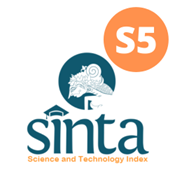Contrastive Analysis of Verb Suffix Formation in Indonesian And German Language
(1) Universitas Negeri Makassar
(2) Universitas Negeri Makassar
(3) Universitas Negeri Makassar
(*) Corresponding Author
DOI: https://doi.org/10.26858/phonologie.v4i2.62816
Abstract
Abstract. The main concern of the study is the verb construction process through suffixes in Indonesian and German by using contrastive analysis. The primary purpose of this study is to find the types of suffixes that can be used to build the verb in both languages, namely the Indonesian and German. By using a literature review and contrastive analysis approach, the similarities and the distinction between the two languages can be shown, so as to facilitate typical Indonesian students to learn the German language or vice versa. The results of the study showed that verb suffix construction in Indonesian consists of suffix i- and suffix –kan, both of which foster the imperative verbs (commands). Meanwhile, the verb suffix formation in German consists of suffix -el,-er, and-ig. The three suffixes can form the verb if they are attached to verbs, nouns and adjectives. In addition to all three suffixes, there are also other suffixes that often attach to verbs when conjugated, such as, the suffix –e, -st (-est),-t (-et), and -en for the present tense (Prӓsen) and the suffix –te, -test (-etest), -tet (-etet), -ten (-eten) for past tense (Prӓteritum) in regular verbs.
Keyword: verb, suffixes, Indonesian, German, contrastive analysisFull Text:
PDFReferences
Bauer, L. (2003). Introduction Linguistic Morphology. Secon Edition. Edingburgh: University Press.
Booij, G. (2005). The Grammar of Words. An Introduction to Linguitic Morphology. New York. Oxford University Press Inc.
Crystal, D. (2008). A Dictionary of Lingustics and Phonetics. Six Edition. Massachusetts: Blackwell Publishers.
Departemen Pendidikan Nasional Republik Indonesia. (2008). Kamus Besar Bahasa Indonesia. Jakarta
Dieter; Haensch, Günther; Wellmann, Hans. (1997). Langescheidts Groβwӧrterbuch, Deutsch als Fremdsprache. Berlin, Langenscheidt.
Hardiyanti, S. U., Sawardi ,F.X, Sumarlam. (2021). Pembentukan Verba Bersufiks –i dari Dasar Nomina Dalam Bahasa Indonesia. Prosiding Seminar Nasional Linguistik dan Sastra (SEMANTIKS). Prospek Pengembangan Linguistik dan Kebijakan Bahasa di Era Kenormalan Baru. ISBN: 978-623-94874-1-6 https://jurnal.uns.ac.id/prosidingsemantiks 268. Diakses 29.05.2024.
Haryono, A. (2002). Analisis ‘Kasus’ dalam bahasa Jerman dan bahasa Inggris: studi komparatif historis. JIBS (Jurnal Ilmu Bahasa dan Sastra) Vol. 2/ No. 1/ Januari – Juli 2002.
Hasmawati, Seong, Teo Kok, Shin, Chong. (2014). Proses Semantik Kata Kerja Bahasa Indonesia dan Bahasa Jerman. International Journal of the Malay World and Civilisation (IMAN), 2 (1). pp. 53-62. ISSN 2289-1706.
Heuken SJ, Adolf . (2007). Kamus Jerman Indonesia. Jakarta: Gramedia Pustaka Utama
Katamba, F and Stonham, J. (2006). Morphology. Second Edition. New York. Publish by Palgrave Macmillan,
Sayogo, A. A.,; Wijana, I Dewa Putu. (2011). Afiksasi Derivasional Pembentukan Verba Dalam Bahasa Jerman. Jurnal online Universitas Gajah Mada. https://etd.repository.ugm.ac.id/
Suryani; Fitriyah ,Lailatul,;Supangat. (2019). Afiks Pembentuk Verba dalam Bahasa Indonesia dan Bahasa Arab (Analisis Kontrastif). JURNAL KATA (Bahasa, Sastra, dan Pembelajarnnya) Vol 7, No 1 Apr (2019)
Trask.R.L. (2000). The Dictionary of Historical of Comparative Lingistics. Edinburgh University Press Ltd.
Article Metrics
Abstract view : 22 times | PDF view : 3 timesRefbacks
- There are currently no refbacks.














